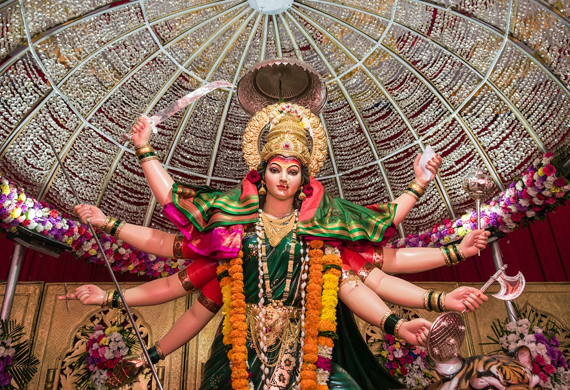
Unique Navratri Traditions from Across India
By: WE Staff
Navratri, India's vibrant festival, celebrating Goddess Durga in various forms, is a tapestry of diverse regional traditions. It embodies unity, cultural richness, and the triumph of good over evil.
Navratri is one of the most popular and vibrant festivals in India, celebrated with great fervour and devotion across the country. The festival, which means nine (nav) nights (ratri), honours the nine forms of Goddess Durga, the supreme feminine power in Hinduism.
The festival symbolises the triumph of good over evil, as Durga defeats the demon Mahishasura after a fierce battle that lasts for nine days and nights. The festival also marks the onset of autumn and the beginning of the festive season in India.
Navratri is celebrated in different ways in different regions of India, reflecting the rich diversity and cultural heritage of the country. Each region has its unique traditions, rituals, customs, and cuisine that add to the charm and splendour of the festival.
Gujarat:
In Gujarat, Navratri transforms into a grand spectacle of dance and devotion. Kejal Shah, Co-Founder, of BeBetta, takes a walk down memory lane and tells us how her family celebrates Navratri.
“In my family, Navratri is a time of joyful togetherness and spiritual devotion. We decorate our home with colourful Rangoli and idols of Goddess Durga. Evenings are marked by vibrant Garba and Dandiya dance performances with friends and neighbours, fostering community bonds. We also observe fasts, offer special prayers to the goddess and relish traditional vegetarian meals. It's a time for new outfits and sharing festive sweets with loved ones. Navratri, for us, is a harmonious blend of religious reverence, cultural celebration, and the warmth of family and community gatherings.”
Much like Kejal’s family, thousands of people gather in open grounds or stadiums to perform garba and dandiya, two traditional folk dances that involve rhythmic movements with sticks or claps. The dances are accompanied by lively music and songs that praise Durga and her various aspects. The dances also have a social significance, as they provide an opportunity for people to mingle and bond with each other.
The last night of Navratri, called Sharad Purnima, is considered to be the most auspicious night when devotees offer prayers to the moon goddess and seek her blessings.
West Bengal:
In West Bengal, and most eastern states like Assam, Tripura, Odisha and Jharkhand, Navratri is celebrated as Durga Puja, the main annual festival for Bengali Hindus that commemorates the victory of Durga over Mahishasura. During the celebrations, elaborately designed pandals (marquees) and life-size statues of Durga are installed in every neighbourhood.
Dressed in traditional attire, devotees offer prayers in the evening and perform a dhunuchi naach, a special dance with earthen lamps. The pandals also host various cultural programmes, such as music, dance, drama, and poetry recitals. The festival reaches its climax on the tenth day, called Vijaya Dashami, when the idols of Durga are immersed in rivers or lakes amid chants of "Bolo Durga Mai Ki Jai" (Hail Mother Durga).
Tamil Nadu:
In Tamil Nadu, Navratri is celebrated as Golu or Kolu, which means a display of dolls. The festival is dedicated to three goddesses: Durga (the goddess of valour), Lakshmi (the goddess of wealth), and Saraswati (the goddess of knowledge). During the festival, devotees arrange dolls of gods, goddesses, saints, animals, birds, and humans on a stepped platform called kolu padi.
The dolls are usually made of clay or wood and are handed down from generation to generation. The display also includes lamps, flowers, fruits, sweets, and other offerings. The festival is also a time for socialising and exchanging gifts among friends and relatives. Women visit each other's homes to admire their doll displays and sing devotional songs. They also offer kumkum (vermilion) and turmeric to each other as a sign of respect and friendship.
Punjab:
In Punjab, Navratri is celebrated with jagraata or jagran, which means staying awake all night to worship Durga. Devotees observe fasts for seven days and break them on the eighth day or Ashtami by offering halwa (sweet pudding) and poori (fried bread) to young girls as a symbol of Durga.
On each night of Navratri, devotees gather in temples or community halls to sing bhajans (devotional songs) and chant mantras (sacred words) in praise of Durga. They also perform aarti (ritual waving of lamps) and offer prasad (sacred food) to the goddess. The jagraata is believed to bring blessings and protection from Durga to those who participate in it.
Rajasthan:
In Rajasthan, Navratri is celebrated with mata ka jagran or mata ki chowki, which means keeping awake for the mother goddess or sitting at her feet. Devotees decorate their homes with colourful lights and flowers and install idols or pictures of Durga or her various forms such as Amba, Bhawani, Chamunda, etc. They also observe fasts for nine days and offer fruits, flowers, sweets, coconut, etc. to the goddess.
On each night of Navratri, devotees invite singers or musicians to perform mata ka jagran or mata ki chowki, which involves singing devotional songs and telling stories about Durga and her deeds. The songs are usually accompanied by instruments such as harmonium, tabla, dholak, etc. The jagran or chowki is attended by friends, relatives, and neighbours who join in the singing and dancing. It is considered to be a way of expressing gratitude and devotion to the mother goddess and seeking her blessings.
Navratri, celebrated across India, highlights our nation's diverse culture and unifying faith. It embodies our deep respect for Goddess Durga, symbolizing strength and compassion. This festival, with its regional variations, is a testament to our rich traditions.
Navratri signifies the triumph of good over evil, joy over sorrow, and the divine over the ordinary. It's a reminder of our collective strength in unity, showcasing the beauty of India's cultural tapestry.
Let Navratri inspire us to cherish and preserve our rich heritage, fostering unity and cultural diversity that make India truly unique and harmonious.


.jpg)



